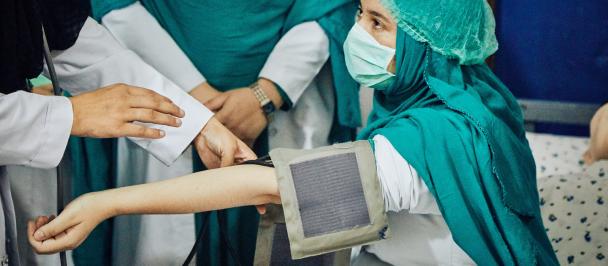Governments of the Future: Leveraging Innovation and New Technologies for the 2030 Agenda
Governments of the Future
February 12, 2018
As prepared for delivery.
Let me start with a frank confession: I am a passionate believer in the potential of technology as we make sustainable development and inclusive societies a reality.
My faith in technology’s potential is grounded in solid evidence and personal experience. My generation witnessed how mobile phones, for instance, profoundly changed the daily lives of billions of poor people within a single generation in both developing and developed countries.
Cognitive computing, blockchain, robotics, the Internet of Things and all things ‘smart’ and ‘digital’ hold great promise as new, potentially disruptive, technologies which are likely to have the same profound impact on development.
Nanotechnology, 3D and 4D printing, virtual, augmented and mixed reality, sophisticated digital assistants, autonomous vehicles, and cutting-edge genetic technologies - the list of technological megatrends just keeps growing at an unprecedented pace in what is now often referred to as “the 4th industrial revolution”.
Over the next ten years, artificial intelligence is expected to be the most disruptive of technologies due to the enormous computational power deployed, amounts of data collected, and advances in deep neural networks. This presents us with unprecedented potential in problem-solving and harnessing data to tackle the targets under our 2030 Agenda for Sustainable Development, agreed by UN member states in 2015.
It is important to note that, as a promoter of innovation, and often as the innovator itself, government has been a key actor in technological progress. Research has highlighted how it was “public funding that drove both the IT revolution and other fields such as bio- and nano-technologies and today’s green technologies.” Where Governments decide to put support and create conducive policy and legal frameworks, they can continue to foster tremendous innovation for positive change.
Between Governments and the international community, we need to keep an informed conversation going, understand the interplay between technology and sustainability, and stand together to maximise the good that technology can bring.
I am therefore convinced that the judicious use of technology will be a key accelerator and enabler for many, perhaps all, of the seventeen Sustainable Development Goals – the SDGs.
Indeed, the 2030 Agenda for Sustainable Development recognises that "the spread of information and communication technology and global interconnectedness has great potential to accelerate human progress, to bridge the digital divide and to develop knowledge societies".
Technology is explicitly referred to in Goal 9 (industry, innovation and infrastructure). Its target 5, for example, calls for the international community to: 'Enhance scientific research, upgrade the technological capabilities of industrial sectors in all countries, in particular developing countries, including, by 2030, encouraging innovation and substantially increasing the number of research and development workers per 1 million people and public and private research and development spending.'
Various other SDG targets have a significant technology component.
For example, there are benefits of digital technologies and services in health (SDG 3): e health applications can provide the opportunity for rural patients to benefit from remote diagnosis and improve their adherence to treatment. Innovation in low-cost health technologies, such as neonatal incubators or solar-powered vaccine refrigerators, can save lives in resource-constrained settings.
But perhaps the most interesting story is how technology will help to promote peace, justice and strong institutions (SDG 16). Around the world, digital technologies are promoting access to public information and improving transparency of public institutions. The results are helping the public sector become more efficient and effective. Achieving the targets set in SDG 16 is crucial for all aspects of the 2030 Agenda.
SDG 16.9 calls for the provision of legal identities for all, including birth registration. Proper and secure identification is a precondition for people to be citizens in their countries. Legal identity is the key to the exercise of political rights, such as the right to vote.
But some 1.1 billion people, nearly one in six individuals globally, usually the poorest and most marginalised members of society, more than a third of them children under 18, are not registered as citizens. Identification is the first and most fundamental prerequisite for government to be able to interact with, and provide services to, its citizens. Without identification, citizens are likely to be excluded from public services, such as healthcare, education, welfare and financial services.
For the developing world, electronic identity (eID) schemes offer the potential to overcome existing barriers to citizen registration, such as inadequate physical infrastructure, illiteracy and corruption. One outstanding example is India’s Aadhaar programme that provides authentication primarily based on fingerprints or an iris scan. Many Governments in the developing world are currently implementing or considering technology-enabled identity schemes.
Government interacts with technological innovation on multiple levels. As users and as regulators, governments must ensure that the applications of new technologies adhere to the rule of law and are in accordance with the central tenets of good governance, legality, transparency and accountability.
Innovation will cause profound change. Without effective institutions, technology could undermine relations between citizens and the state by infringing on privacy and human rights. Without doubt, innovation and technological change on scales forecasted promise to alter the way power is distributed and used within societies. States with effective institutions, however, will be better able to adjust to the effects of disruptive technologies, including on jobs, and strengthen the social contract through the constructive capacity of social media to mobilise collective action.
All this calls for competence in foresight – the art of considering alternative futures and gleaning insights for today’s actions. Deploying strategic foresight methods in Government enables decision makers to be proactive rather than reactive in handling this rapidly changing environment, empowering them to take advantage of emerging opportunities and to become more resilient in the face of disruption and emerging challenges.
The use of new technologies – both in the public and private sector – profoundly affects citizens’ trust in government. That in turn shapes the legitimacy of the state, the political foundation of the social stability on which sustained economic growth and development depend.
With this in mind, the UN System is already supporting Governments in accelerating SDG implementation through technology.
For example, the UNDP in Kuwait is supporting the Government of Kuwait in establishing a Behavioral Insights Policy Appraisal Lab, with the aim of applying behavioral economics in public policies. The UN has similarly supported governments in Armenia, Bangladesh, Moldova and Sri Lanka with designing and launching policy innovation labs, helping to engage citizens as co-creators of public services.
The UN is working in places like Lebanon, Palestine, Somalia, Sudan and Yemen to harness decentralized solar solutions to ensure energy supplies, empowering communities, helping to ensure resilience and recovery from crisis.
Similarly, UNDP’s Solar for Health initiative supports several African, Central Asian and Arab State governments to increase access to quality health services by equipping health centres with solar panels. Ensuring reliable and cost-effective access to electricity in this way not only saves lives but also reduces CO2 emissions. Partners include solar panel producers, local governments and communities.
In partnership with the Global Alliance for Vaccines and Immunisation (GAVI), the UN is also supporting India’s Ministry of Health and Family Welfare to roll out an innovative mobile application that provides real-time information on cold chain temperatures and vaccine stocks and is significantly helping India’s progress towards universal vaccine coverage. With UN support, the Ministry of Health in Indonesia are in the process of replicating this innovation.
These sort of opportunities, offered by disruptive technologies, could help developing countries to leapfrog obsolete generations of technology and become digital leaders of their own development priorities.
But the dividends of using digital solutions to promote development will only be achieved if the ‘digital divide’ is overcome. Internet connectivity can empower people and provide access to education and other public and private services. But it may also create new dependencies on developed world technological expertise, and vulnerabilities, such as to hacking.
We are all struggling to keep up with the knowledge, skills and tools required to harness the opportunities and mitigate the risks of disruptive technology innovations. Artificial intelligence can assess national development strategies many times faster than UN experts, possibly putting me out of a job in the not too distant future.
Cybersecurity will be an increasing concern. The collapse of critical infrastructure, such as power grids or air traffic systems, due to cyberattack could have catastrophic consequences for development.
All countries will therefore need to adapt to ensure that governments are prepared for this ‘4th Industrial Revolution’. Governments must also help business adapt to digital global competition, and workers’ skills to the demands of the emerging digital economy. Safeguarding people against risk, by ensuring adequate social protection, skills training and education, is not an easy task. But the UN system can help by ensuring that key lessons and best-practices about managing shocks and technological disruptions are shared between countries and sectors.
So let’s be frank about the challenges it will cause as technology advances at an unprecedented pace. Technologies do not come without risk, and not all technologies and risks are equally shared.
Technology-driven growth can have a disproportionate impact across countries, industries, and workers.
These are valid worries. I believe the UN will play an important role in addressing such dangers by working with its partners in government, the private sector and civil society.
Uncertainty is at the heart of technological change and innovation. Governments must provide an enabling policy and regulatory environment.
But, while innovation and new technologies can be powerful tools to accelerate the pace of development, to be successful, investment in technological innovation must be guided by political leadership, and underpinned by a skilled workforce capable of reaping the “digital dividend”, and, above all, effective public institutions.
Thank you.

 Locations
Locations




